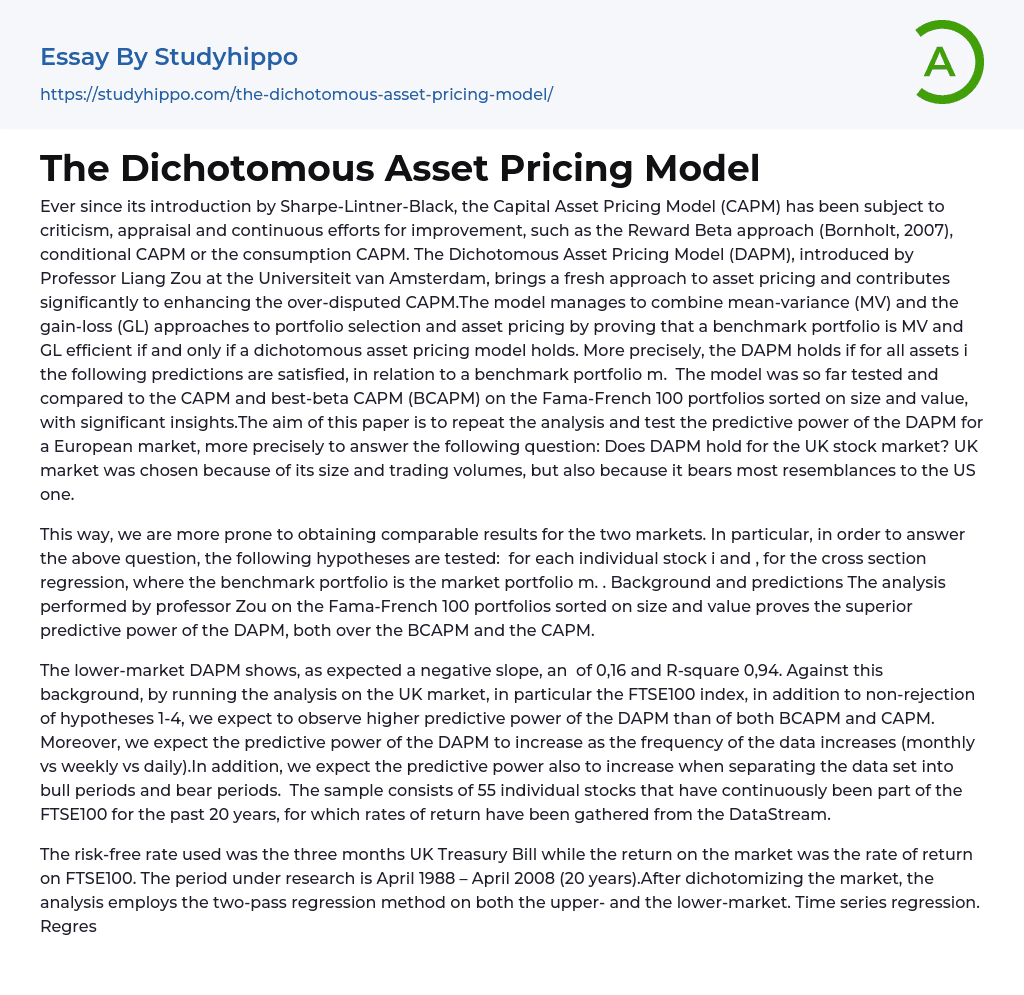Ever since its introduction by Sharpe-Lintner-Black, the Capital Asset Pricing Model (CAPM) has been the subject of criticism, appraisal, and continuous efforts for improvement. These efforts include the Reward Beta approach (Bornholt, 2007), conditional CAPM, and the consumption CAPM. Professor Liang Zou at the Universiteit van Amsterdam introduced the Dichotomous Asset Pricing Model (DAPM), which offers a fresh perspective on asset pricing and significantly contributes to enhancing the disputed CAPM.
The DAPM combines mean-variance (MV) and gain-loss (GL) approaches to portfolio selection and asset pricing. It establishes that a benchmark portfolio is MV and GL efficient if and only if a dichotomous asset pricing model holds. The model's predictions must be satisfied for all assets i in relation to a benchmark portfolio m. The DAPM has been tested and compared to CAPM and best-
...beta CAPM (BCAPM) on the Fama-French 100 portfolios sorted by size and value, yielding significant insights.
The aim of this paper is to replicate the analysis and examine the predictive power of the DAPM specifically for the UK stock market. The UK market was chosen due to its size, trading volumes, and similarities with the US market.
In order to achieve comparable results for the two markets, we test the following hypotheses: for each individual stock i and for the cross section regression, with the market portfolio m as the benchmark portfolio. Professor Zou's analysis on the Fama-French 100 portfolios sorted by size and value demonstrates the superior predictive power of the DAPM over both the BCAPM and the CAPM. The DAPM for the lower-market shows the expected negative slope of 0.16 and an R-square of 0.94.
Against this background, the analysis of the UK market
specifically the FTSE100 index, is expected to demonstrate a higher predictive power of the DAPM compared to both BCAPM and CAPM. Moreover, this predictive power is anticipated to increase as the frequency of the data (monthly, weekly, daily) and the separation of the dataset into bull and bear periods are considered. The sample comprises 55 individual stocks from the FTSE100 over a continuous 20-year period, with rates of return obtained from DataStream. The risk-free rate used is the three months UK Treasury Bill, while the market return is based on FTSE100's rate of return. The research period spans from April 1988 to April 2008 (20 years). The analysis utilizes the two-pass regression method on both the upper- and lower-market segments.
Time series regression. The excess returns of each stock are regressed on the market excess return to obtain an estimated value, while forcing the intercept to be 0. The same significance tests were conducted for this second regression to determine if hypotheses H3 and H4 can be rejected. To ensure refinement and increased accuracy, the analysis was performed at different levels: daily, weekly, and monthly for all 20 years, as well as separately for bullish and bearish periods.
Research results 5. 1 DAPM To test hypothesis 1, we initially examined the average alpha of each of the 55 stocks.
- Investing essays
- Asset essays
- Depreciation essays
- Discounted Cash Flow essays
- Foreign Direct Investment essays
- Funds essays
- Internal Rate Of Return essays
- Revenue essays
- Day Trading essays
- Futures Trading essays
- Capital market essays
- Million essays
- Payment essays
- Rate Of Return essays
- Funding essays
- Hedge Fund essays
- Bank essays
- Banking essays
- Corporate Finance essays
- Credit Card essays
- Currency essays
- Debt essays
- Donation essays
- Enron Scandal essays
- Equity essays
- Financial Accounting essays
- Financial Crisis essays
- Financial News essays
- Financial Ratios essays
- Financial Services essays
- Forecasting essays
- Foreign Exchange Market essays
- Free Market essays
- Gold essays
- Investment essays
- Legacy essays
- Loan essays
- Market Segmentation essays
- Money essays
- Personal finance essays
- Purchasing essays
- Retirement essays
- Shareholder essays
- Stock Market essays
- Supply And Demand essays
- Venture Capital essays
- Administration essays
- Architect essays
- Discipline essays
- Doctor essays




